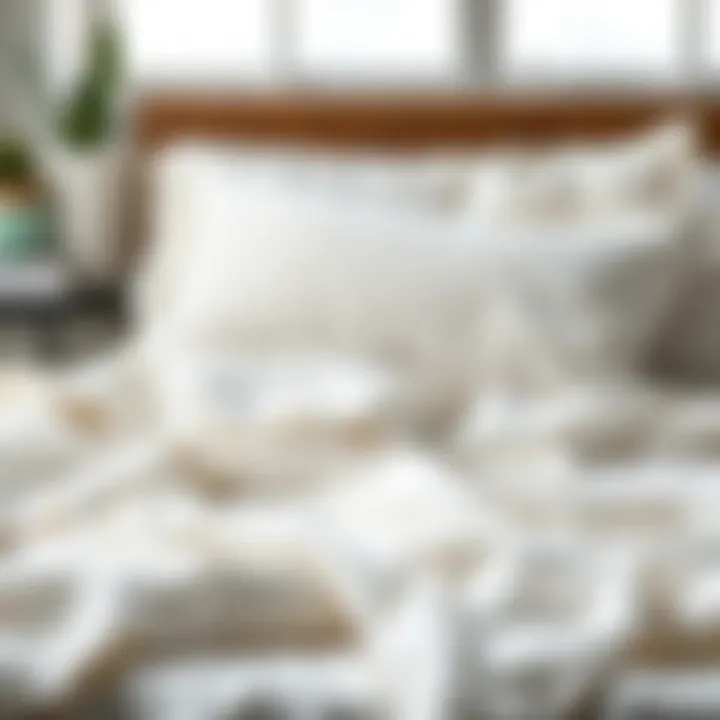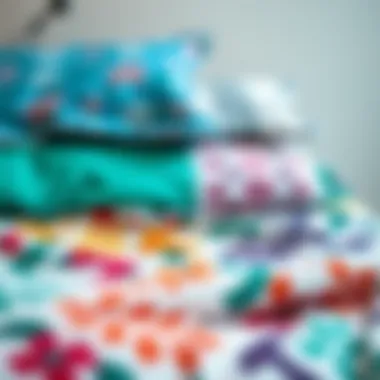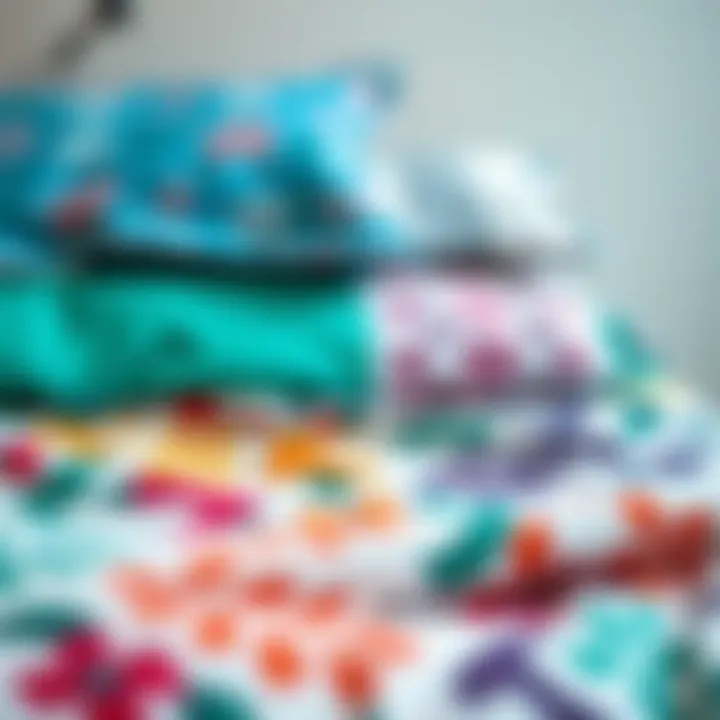Comprehensive Guide to Selecting Sheets for Your Home


Intro
In the realm of home decor, the choice of bed sheets often goes underappreciated, yet it holds significant influence over the overall ambiance of a bedroom. With options aplenty, selecting the right sheets can be a daunting task for many. It’s not just about the color or the pattern; one must consider various factors, like material, thread count, and maintenance. This guide aims to encapsulate everything you need to know about choosing sheets that not only suit your aesthetic but also meet the practical needs of your household.
Furniture Design Trends
Current Styles and Themes
A bedroom should reflect its occupant’s personality. Recent trends indicate a shift towards minimalist and eco-friendly designs. Natural fabrics like organic cotton or linen are gaining popularity, aligning with rising consumer consciousness about sustainability. Such materials not only feel good but also contribute to a healthier living environment.
Additionally, the timeless elegance of classic designs, such as French country or mid-century modern, continues to captivate many homeowners. Each theme comes with its unique color schemes and textures that can dramatically alter the feel of your space. For instance, deep jewel tones can create a cozy, luxurious aura, while softer pastels evoke a calm and airy atmosphere.
Color Palettes and Materials
Choosing colors that resonate with your existing decor can tie the room together seamlessly. Rich, warm colors like burgundy and forest green cater to those looking for a touch of opulence. In contrast, light shades like beige and soft blues can evoke tranquility; an ideal choice for promoting restfulness.
However, it’s not only about color. The material plays a pivotal role in how the sheets feel against your skin and how they perform. Here are some common materials to consider:
- Cotton: Breathable and soft, great for everyday use.
- Linen: Excellent for warm climates, as it remains cool and becomes softer with each wash.
- Bamboo: Known for its ecological benefits, it’s also hypoallergenic and moisture-wicking.
- Silk: Luxurious and smooth, perfect for creating a sumptuous feel. Quite delicate, requiring careful maintenance.
Each material has its pros and cons, and the choice often boils down to personal preferences and lifestyle considerations.
Practical Furniture Tips
How to Choose the Right Size
Selecting the appropriate size is fundamental. Standard sizes include twin, full, queen, and king, but remember to factor in depth as well. Mattress thickness varies widely, and sheets that don't fit well can lead to an uncomfortable sleeping experience. A fitted sheet that’s too small will pop off during the night, while one that’s too large can lead to unwanted bunching. Double check your mattress dimensions before investing.
Maintenance and Care for Longevity
Taking care of your sheets is just as critical as picking the right ones. Here are some key tips to enhance their lifespan:
- Wash Regularly: Aim for a wash every one to two weeks. Use a gentle cycle and cool water to avoid wear and fading.
- Dry Naturally: If possible, air-dry your sheets to maintain their elasticity. If using a dryer, opt for a low heat setting.
- Store Properly: Keep sheets in a cool, dry place, ideally folded neatly to avoid creases.
By keeping these maintenance strategies in mind, you can ensure your selected sheets remain a comfortable addition to your home for years to come.
"Choosing the right sheets transforms a bed from a mere sleeping space to a personal sanctuary."
Armed with knowledge about current trends, styles, materials, and practical care tips, you’re now primed to make a more informed decision as you explore the world of sheets. This guide is designed to steer you through the myriad of choices so you can find the perfect fit for your home.
Prelude to House Sheets
When it comes to your home, few items are as fundamental to comfort and well-being as your bedding. The right sheets not only enhance the sleeping experience but also play a significant role in the overall aesthetic of your bedroom. This section aims to unpack the importance of selecting quality sheets, emphasizing why it should be on every homeowner's radar.
Your choice of sheets goes beyond mere fabric; it encompasses various elements that can impact your health, comfort, and even the longevity of your bedding ensemble. For instance, the difference between a soft, breathable cotton sheet and a rougher, synthetic option can mean the difference between a peaceful night's sleep and a restless one.
Additionally, let’s explore how sheets contribute to the vibe of your space. They can act as a canvas, showcasing your personal style while tying together the design elements of a room. A well-chosen sheet set can complement your décor, making everything from wall color to furniture pop.
Benefits of Selecting the Right Sheets
- Comfort: High-quality sheets are essential for a good night's sleep. They should feel soft against your skin and allow for airflow, helping to regulate your body temperature.
- Durability: Investing in superior materials means that your sheets will stand the test of time, enduring multiple washes without losing their shape or softness.
- Aesthetic Appeal: Sheets are often overlooked in the grand scheme of bedroom decor, yet they can dramatically influence the room's ambiance.
- Health Considerations: Certain fabrics can be more hypoallergenic, reducing the chances of allergic reactions. In contrast, materials with less breathability can trap heat and moisture, creating an environment perfect for dust mites and other allergens.
Considerations Before Making a Purchase
As you dive into the market of sheets, keep in mind a few considerations:
- Material: From cotton to bamboo, each type offers distinct pros and cons.
- Thread Count: This often-debated number can influence feel and durability.
- Size: Ensuring that sheets fit your bed properly is crucial for not only looks but also functionality.
"Your sheets are your haven for rest. Choose wisely."
By understanding the pivotal role sheets play in both comfort and style, readers can make better-informed choices that cater to their specific needs and preferences. Now let’s move forward into the various types of sheets available in the market.
Understanding Sheet Types
Knowing the different types of sheets is crucial for making an informed bedding choice. Sheets are more than just fabric; they play a significant role in your overall sleep experience. The style and function directly impact comfort, ease of care, and even how your bedroom looks. Each type of sheet serves a specific purpose and offers unique benefits, making it essential to understand what suits your needs best.
Flat Sheets
Flat sheets, as the name suggests, are rectangular pieces of fabric spread over the mattress. They serve multiple purposes: they protect your comforter or duvet, add an extra layer of warmth in cold weather, and create a barrier between you and the mattress itself. If you enjoy tucking in your sheets tightly, a flat sheet allows for this, delivering a neat, hotel-like appearance.
Another benefit of flat sheets is their versatility. You can dress your bed with a flat sheet over a fitted sheet for a more polished look, or easily switch it out for different colors or patterns to refresh your decor without a significant investment. Flat sheets also lend themselves to creative layering and texture combinations, allowing you to personalize your bedroom.
However, one consideration to keep in mind is that they may not stay put if you move around a lot during sleep. This issue can be circumvented by carefully tucking in the sides or opting for bedding with known wrinkle-resistant properties.
Fitted Sheets
Fitted sheets are specifically designed to fit snugly over your mattress, with elasticized edges that hold them in place. This design feature eliminates the frustration of sheets riding up during the night, providing an uninterrupted sleep experience. Fitted sheets are particularly advantageous for those who tend to toss and turn, as they remain secure no matter how much you shift.
An additional perk of using fitted sheets is the variety of depths available. This is important since mattresses come in varying thicknesses. You can find fitted sheets that cater to standard depths or deeper pockets, ensuring a proper fit across your bedding collection.
When it comes to maintenance, fitted sheets are relatively easy to wash and store, as their shape lends to convenient folding. They are usually paired with a flat sheet, allowing you to create a cohesive bedding set. Additionally, if you choose sheets with cooling properties or hypoallergenic options, they can enhance your sleeping environment significantly.
Sheet Sets
Opting for sheet sets is a great way to ensure that your bedding looks coordinated and stylish. A typical sheet set comprises a fitted sheet, a flat sheet, and one or two pillowcases. The cohesion of samples can balance the colors and patterns in your bedroom décor effectively, creating an aesthetic that this appealing.
Purchasing a sheet set can also offer cost savings compared to buying individual pieces separately. As a buyer, you often get more for your buck when you go the set route. Consider your personal taste as well— do you lean more toward solid colors or bold patterns? A coordinating set allows you to express your style while saving time on choosing individual sheets.
On the flip side, some find it challenging to mix and match when they go with a full set, which could limit creativity in bedding design. However, mixing and matching isn’t without its own charm. A slightly mismatched combo can reflect a more lived-in ambience.


Selecting the right sheets doesn't just enhance your bedroom aesthetic; it elevates your overall sleeping experience.
Understanding these three foundational types of sheets—flat, fitted, and sets—helps you navigate the bustling marketplace more effectively and allows you to craft a sanctuary that enhances both comfort and style.
Material Considerations
When it comes to selecting sheets for your home, the material from which they are made can greatly influence your overall comfort and satisfaction. Various fabrics possess unique qualities, making it essential to choose the right one that aligns with your needs and lifestyle. A deeper understanding of the benefits and characteristics of different materials will empower you to refine your selection, ensuring a restful night's sleep.
Cotton Sheets
Cotton sheets have earned their reputation as a staple in many households. Known for their breathability and softness, cotton provides a classic feel that many find hard to resist. There are several varieties of cotton, but Egyptian and Pima cotton are often highlighted for their long fibers, which create stronger and more luxurious sheets.
- Benefits:
- Durability: Cotton sheets tend to last longer than many other materials.
- Comfort: They wick moisture away, keeping you cool in the summer and cozy in the winter.
It’s also worth noting that cotton is hypoallergenic, reducing the chances of irritations for those with sensitive skin. All in all, cotton’s versatility makes it suitable for all seasons and various home aesthetics.
Linen Sheets
Linen sheets offer a touch of elegance while also promising comfort and a unique texture. Made from flax fibers, these sheets have a reputation for being incredibly durable and having a nice, relaxed look.
- Benefits:
- Temperature Regulation: Linen keeps you cool because of its ability to absorb and release moisture, making it ideal for warmer climates.
- Sustainability: Flax requires less water than cotton, making it a more eco-friendly choice.
One downside, however, is that linen can feel a bit rough when first used, but it softens beautifully over time, giving it a lived-in charm.
Microfiber Sheets
Microfiber sheets are made from polyester fibers that are much finer than silk. This material has gained popularity for its affordability and ease of care. It tends to be wrinkle and stain-resistant, which is a major plus for busy households.
- Benefits:
- Affordability: Microfiber offers a budget-friendly option without sacrificing quality.
- Softness: They are remarkably soft, often feeling like a gentle hug around your body.
However, it's important to note that microfiber is not as breathable as natural fabrics, which may be an issue for hot sleepers. Still, for those on a budget or looking for low-maintenance bed linens, microfiber sheets are a practical choice.
Bamboo Sheets
Bamboo sheets are often marketed as a luxurious alternative that focuses on sustainability. They are derived from the pulp of the bamboo plant and have unique properties that attract conscientious consumers.
- Benefits:
- Eco-Friendly: Bamboo is a rapidly renewable resource, making these sheets better for the planet.
- Hypoallergenic and Antibacterial: They offer a breathable option that can reduce allergic reactions and keep unwanted odors at bay.
However, finding high-quality bamboo sheets might require some research, as the manufacturing process can vary. It’s wise to choose brands that prioritize responsible practices.
Quality matters. Invest time in selecting sheets that fit your lifestyle for the best sleeping experience.
Understanding the different materials available for sheets can transform the way you experience your bed. From cotton's classic comfort to the modern sustainability of bamboo, there's a fabric out there designed for your needs and preferences. Choosing wisely can enhance your rest and elevate your bedroom's ambiance.
Thread Count Demystified
When it comes to choosing the right sheets, thread count is a term that comes up frequently, yet many people still find it a bit of a mystery. In this section, we aim to dissect this concept, explaining its importance and how it plays a role in the overall quality and comfort of your bedding.
What is Thread Count?
Thread count refers to the number of threads woven into one square inch of fabric. This includes both vertical (warp) and horizontal (weft) threads. Various factors influence the measurements—like the type of fabric or how it's woven. Commonly touted as a hallmark of quality, a higher thread count can signify a denser and potentially softer fabric. However, it can also lead to a lack of breathability, particularly in materials that trap heat, making for an uncomfortable night's sleep.
It's key to note that not all fibers respond the same way to threading. For instance, cotton tends to feel softer and more luxurious at higher counts, while synthetic fibers may not provide the same level of comfort. Simply stated, while higher numbers may catch the eye, it's essential to consider the material and weave when evaluating sheet quality.
Ideal Thread Counts
Now, let’s get to the crux of the matter: what’s the ideal thread count? Well, that's like asking how long a piece of string is. It varies based on preferences and materials. However, here’s a concise breakdown:
- 200-400: Generally a good range for cotton sheets. It provides enough density for durability while keeping the fabric breathable. Most budget-friendly options fall within this range.
- 400-600: Any sheet that falls in this zone offers extra softness and perhaps a luxurious feel without being overly heavy. Great for those who fancy comfort but don't want tooverheat.
- 600 and above: High thread counts, like those above 800, may feel opulent, but sometimes it's a marketing trick. Manufacturers may use multi-ply threads to inflate the numbers rather than truly enhancing quality.
"A higher thread count doesn't automatically mean better sheets. You need to evaluate the material as well."
While a thicker fabric may sound appealing, don’t overlook how it could feel during warm nights or influence your laundry routine. Ultimately, ideal thread counts balance comfort and practicality. Remember, it's not just about numbers; it's about how those sheets feel against your skin and hold up over time.
By understanding thread count and its implications, you’ll be better equipped to select sheets that truly enhance your sleeping experience.
Sizing Your Sheets
Choosing the right size for your sheets is not just about finding a perfect fit for your mattress; it’s about ensuring comfort, functionality, and enhancing your overall bedroom aesthetic. Just as a well-tailored suit enhances one’s appearance, properly sized sheets elevate your sleeping experience. Getting the sizing right can make or break your bed setup, affecting everything from how smoothly the sheets lay on your mattress to how cozy you feel each night.
When sizing sheets, knowing the dimensions of your mattress is the first step. However, one must also consider the height of the mattress, which can vary widely, especially with plush pillow tops or memory foam layers. If you miss the mark here, you might find yourself wrestling with sheets that come off too easily or ones that feel tight and uncomfortable. The result? A restless night’s sleep and an unnecessary source of frustration.
Common Bed Sizes
Understanding common bed sizes is essential for making a wise purchase. Most sheets on the market are designed to fit standard dimensions. Here's a quick rundown of typical mattress sizes along with their corresponding sheet dimensions:
- Twin: 39" x 75"
- Twin XL: 39" x 80"
- Full/Double: 54" x 75"
- Queen: 60" x 80"
- King: 76" x 80"
- California King: 72" x 84"
These measurements should guide your choices, but also be on the lookout for mattress depths.
Deep Pocket vs. Standard Sheets


The choice between deep pocket and standard sheets is crucial, particularly as mattress designs evolve. Standard sheets typically fit mattresses up to 12 inches deep, which is fine for many traditional mattresses. However, with the rise of thicker mattresses, especially those designed for extra comfort, deep pocket sheets have gained prominence.
Deep pocket sheets usually accommodate mattress depths of 14 to 18 inches or more. Choosing them provides several benefits:
"Investing in deep pocket sheets can save you a lot of heartaches; they ensure a snug fit, eliminating the annoyance of sheets slipping off at the corners while you sleep."
Choosing the right type means not getting stuck with sheets that pop off in the middle of the night, leaving you tangled up and annoyed. It’s often the little things like this that turn a good night’s sleep into a great one.
Design and Aesthetic Choices
When it comes to selecting sheets for your home, design and aesthetic choices play a pivotal role. Sheets are not merely functional items; they're a major component of your interior decor. The right sheets can transform a room, setting the mood and reflecting personal style. Color coordination, pattern selection, and seasonal variations should not be overlooked. Each of these elements contributes significantly to how your bedroom feels and looks, providing an opportunity to express creativity and enhance comfort.
Color Coordination
Navigating the world of colors might seem daunting, but it’s worth the effort. First off, think about your bedroom's existing color palette. Harmonizing your sheets with the walls, furniture, and other textiles is essential. For instance, if your walls are painted a soft blue, opting for sheets in complementary colors, like crisp white or pastel shades, can create a serene ambiance. On the flip side, choosing bold colored sheets can add a splash of vibrancy and become the focal point of your decor.
It's also helpful to consider how colors evoke different emotions. Warmer tones are inviting and energetic, while cool tones offer relaxation and peace. Here are a few tips:
- Contrast is Key: If your room decor is neutral, don’t shy away from bold sheets. They can add character without overwhelming.
- Balance Matters: If you choose patterned sheets, balance them with solid-colored duvet covers or comforters.
- Layering Colors: Use throw pillows or blankets to tie colors together, enhancing the overall visual harmony.
"Color is the keyboard, the eyes are the harmonies, the soul is the piano with many strings."
—Wassily Kandinsky
Pattern Selection
Patterns can truly impact the personality of your sheets, and thus your entire bedroom. Floral prints, geometric designs, or stripes each convey distinct styles. When selecting patterns, consider the overall theme of your space. A modern room might benefit from minimalistic geometric patterns, while a vintage-inspired space might welcome delicate floral designs.
Things to keep in mind:
- Scale and Size: The size of the pattern should correlate with the size of the room and furniture. Larger patterns can dwarf small spaces, while tiny prints may get lost in spacious environments.
- Mix and Match: Pairing different but complementary patterns can create visual interest. However, keep a consistent color scheme to maintain cohesion.
- Thematic Consistency: Ensure the patterns resonate with the room's overall theme, whether it’s rustic, contemporary, or eclectic, to keep the decor cohesive.
Seasonal Variations
Changing your sheets with the seasons is a simple yet effective way to refresh your space. In warmer months, lighter fabrics and airy colors can promote a cool feeling in contrast to the outdoor heat. Think of breezy cottons in pastel hues or playful prints.
As the temperature drops, thick, warm fabrics become essential. Opt for deeper colors like navy blues or rich reds, which can evoke coziness. Here are some additional considerations:
- Fabric Choice: In fall and winter, heavier fabrics like flannel or higher thread count cotton can provide warmth. In spring and summer, switch to lightweight materials that allow for breathability.
- Decor Update: Don’t forget to update decorative elements like cushions and blankets to pair with your seasonal sheets.
- Timely Swaps: Having a dedicated time to change out your bedding, like at the start of a new season, can help maintain a refreshed aesthetic.
In essence, the design elements of sheets offer a unique way to express your taste and enhance the comfort of your home. By paying attention to color coordination, pattern selection, and seasonal variations, you can create a bedroom that’s not only visually appealing but also a true reflection of you.
Care and Maintenance of Sheets
Taking good care of sheets is not just a chore; it’s an investment in your comfort and overall well-being. Proper care and maintenance of your sheets extends their lifespan and keeps them looking fresh and inviting. Dirty or poorly cared for sheets can impact your sleep quality and the aesthetic of your bedroom. So, understanding how to maintain them is crucial for homeowners and anyone interested in creating a cozy space.
Washing Instructions
When it comes to washing your sheets, knowing the right techniques is key. First and foremost, always check the care label. It provides valuable information specific to the material composition of your sheets. Generally, here are some tips to help you wash your sheets effectively:
- Frequency: Aim to wash sheets every one to two weeks. This helps eliminate dust mites, allergens, and odors.
- Temperature: For cotton sheets, a warm wash is ideal, but with delicate fabrics like linen or bamboo, cold water is preferable. Hot water can be problematic for certain blends as it may cause shrinkage.
- Detergent: Use a mild detergent that’s free of harsh chemicals. This keeps the sheet fibers intact and avoids irritation to your skin.
- Avoid Overloading: Don’t stuff the washing machine too full. Sheets need space to move around to get clean.
- Drying: If you can, line-dry your sheets for added freshness. If you must use a dryer, opt for a low-heat setting to maintain fabric integrity.
"Taking care of sheets may seem trivial, but it's foundational for a restful night. A little effort goes a long way!"
Ironing and Storing
Ironing is often skipped, but it can do wonders for appearance, especially if you're aiming for a polished look in your bedroom. Wrinkles can detract from the overall aesthetic of your bedding setup. To iron effectively:
- Ironing Temperature: Use a medium heat setting to avoid scorching the fabric. Cotton and linen can handle higher temperatures; however, microfiber and certain blends require more caution to prevent damage.
- Damp Sheets: Ironing sheets while they're slightly damp is beneficial. It allows the iron to glide more smoothly and effectively removes wrinkles.
- Storage: Once ironed, fold sheets neatly and store them in a cool, dry place. Avoid direct sunlight which may fade colors over time. Consider using breathable storage bags to keep them dust-free until next use.
Maintaining sheets is not just about cleanliness; it reflects your style and care for your home. A little diligence in washing and storing your sheets pays off, offering you a serene haven right in your bedroom.
Innovations in Sheet Technology
In today's fast-paced world, the realm of bedding has seen remarkable advancements. Innovative technologies in sheet design and production have transformed ordinary sleep experiences into personalized havens of comfort and wellness. Understanding these developments is essential, particularly for homeowners, interior decorators, and anyone with an eye for aesthetics and functionality in their bedding.
The significance of innovations in sheet technology is evident not only in the enhanced comfort they provide but also in improved health benefits. Sheets that cater to various lifestyles and needs address critical issues such as allergies and temperature regulation. Here, we will delve into two key advancements that have taken center stage in modern bedding: hypoallergenic options and cooling technologies.
Hypoallergenic Options
Allergies can be a major hindrance to a good night's sleep, often making bedding a lurking threat rather than a comfort. That's where hypoallergenic sheets come into play. These specially crafted sheets are made from materials that resist allergens like dust mites, mold, and pet dander. Brands now offer materials like organic cotton and specially treated fabrics that prevent the accumulation of these health nuisances.
- Benefits of Hypoallergenic Sheets:
- Reduce allergy symptoms such as sneezing or itchy skin.
- Perfect for sensitive individuals, including those with asthma or eczema.
- Easy to care for; many are machine washable and retain their integrity after numerous washes.
Investing in hypoallergenic sheets is a smart move for anyone looking to achieve a healthier sleep environment. Not only do they safeguard physical well-being, but they also contribute to more restful nights, making them worth considering.
Cooling Technologies
As seasons change, so do our sleep preferences. Many individuals struggle with overheating at night, resulting in disrupted sleep. Cooling technologies have emerged to combat this issue effectively. Sheets designed with breathability in mind often incorporate advanced materials like moisture-wicking fabrics or gel-infused fibers.
- Key Features of Cooling Sheets:
- Moisture Control: These sheets draw sweat away from your body, ensuring a dry and comfortable sleep surface.
- Breathability: Many are structured to allow airflow, keeping you fresh and less prone to overheating.
- Phase-Change Materials: Some sheets utilize technology that absorbs, stores, and releases heat, adapting to temperature changes throughout the night.
Homeowners are finding that with the right cooling sheets, they can enjoy a much more refreshing sleep, boosting their overall well-being and daily functionality.
Investing in technology-enhanced sheets can significantly enhance your sleep quality while also catering to specific health needs.
By choosing hypoallergenic options and cooling technologies, one can not only pamper themselves but also ensure their bedding supports their lifestyle and health requirements. It’s clear that the innovations in sheet technology are more than just trends; they embody a step toward a more thoughtful and personalized sleeping experience.


Sustainable Sheet Choices
Choosing sheets is not just a matter of comfort and aesthetics; it increasingly involves considering the environmental impact of our choices. As more people are becoming aware of their carbon footprints, selecting sustainable sheets has become essential. This area of the bedding industry now showcases materials and production practices that are not only beneficial to consumers but also to our planet. Opting for sustainable sheets can reduce waste, conserve resources, and promote responsible manufacturing practices.
Eco-Friendly Materials
When it comes to eco-friendly materials for sheets, the market presents several excellent options. Cotton, though widely used, often faces criticism due to conventional farming practices. Instead, organic cotton, grown without synthetic pesticides or fertilizers, offers a greener alternative. This not only ensures that you sleep on chemical-free sheets but also supports healthier ecosystems. Other fantastic materials include:
- Bamboo: Naturally hypoallergenic and biodegradable, bamboo sheets are soft and breathable. The process of turning bamboo into fabric is much less harmful than many traditional methods, making it a top contender for eco-conscious consumers.
- Tencel/Lyocell: Made from sustainably sourced wood pulp, Tencel sheets are known for their silky feel and moisture-wicking properties. They also rely on a closed-loop production process, where solvents used are recycled, minimizing waste.
- Hemp: An incredibly durable fabric, hemp sheets are exceptional for their minimal impact on water and nutrient needs. Plus, they become softer with each wash, providing comfort over time.
These materials not only reduce environmental harm but can also enhance your overall sleeping experience because they are often more breathable and gentle on the skin compared to conventional fabric choices.
Impact of Production Processes
The path from raw material to finished product is fraught with potential environmental impacts. Hence, understanding production processes is a key element in choosing sustainable sheets. Brands that focus on sustainable practices typically employ methods that minimize waste, utilize renewable energy, and ensure fair labor practices. Some key factors to look for include:
- Resource Efficiency: A sustainable production process should ideally use less water and energy. For instance, brands utilizing herbal dyeing processes often consume significantly less water than traditional dyeing techniques, greatly reducing their environmental footprint.
- Local Manufacturing: Supporting brands that manufacture locally can reduce transportation emissions, helping to mitigate overall carbon footprints.
- Certifications: Look for certifications like GOTS (Global Organic Textile Standard) or OEKO-TEX, which denote adherence to environmental and safety standards throughout production.
By prioritizing sheets made from responsibly sourced materials with eco-friendly production processes, you are not just enhancing your sleeping space, but you are also aligning your purchases with your values. The shift towards more sustainable options is a stride in the right direction for a healthier planet.
"Choosing sustainable sheets is more than a trend; it's a commitment to our planet's future."
Incorporating these choices into your home is a win-win: ensuring comfort while safeguarding the environment for generations to come.
Popular Brands and Market Trends
When it comes to selecting sheets for your home, understanding the popular brands and current market trends can significantly influence your choices. Not only do certain brands carry a reputation for quality, but they also often reflect the latest design innovations and consumer preferences. Staying updated on these trends can help you make informed decisions that enhance comfort and aesthetics in your living space.
In the vast world of bedding, the brand you choose matters. Well-established brands tend to invest more in research and development, ensuring their products are made with the latest materials and technologies. This means better durability, comfort, and overall satisfaction for the consumer. Additionally, brand ambiance can reflect your style, speaking volumes about your taste and the environment you wish to create in your bedroom.
Top Luxury Brands
When it comes to luxury, certain names instantly come to mind, synonymous with opulence and top-notch quality. Brands like Frette, Boll & Branch, and Ralph Lauren offer not just sheets, but an experience.
- Frette: Known for its exceptional craftsmanship, Frette has dressed royalty and luxury hotels around the world. Their sheets are often made with Egyptian cotton, which is legendary for its softness and sheen.
- Boll & Branch: This ethical brand has made waves for its commitment to sustainability. They offer organic cotton sheets that are both luxurious and eco-conscious, meeting the needs of the modern consumer.
- Ralph Lauren: Bringing classic design into bedding, Ralph Lauren sheets often feature elegant patterns and colors, catering to those who appreciate traditional aesthetics.
These luxury brands typically carry a heftier price tag, but they often deliver unmatched quality, style, and durability, making them a worthy investment for many.
Affordable Options
Not everyone can splurge on luxury sheets, and that's perfectly fine. The market also offers plenty of affordable options that balance quality and price.
- Target's Threshold line: This brand provides a nice variety without breaking the bank. Their cotton sheets are designed to be soft yet durable, ideal for daily use without sacrificing comfort.
- AmazonBasics: Surprisingly, this brand has embraced the bedding scene. Their microfiber sheets are well-reviewed for being both lightweight and cozy, making them a practical choice for budget buyers.
- Ikea: Known for affordable furniture, Ikea doesn’t skimp on bedding options. Their sheets come in multiple styles and colors, making it easy to find something that fits your aesthetic, even on a budget.
Ultimately, it’s about striking the right balance between quality and affordability. Even a tighter budget should not mean compromising on your sleeping experience. By choosing wisely, you can still enjoy a comfortable night’s sleep.
"When it comes to sheets, never underestimate the importance of a good night's sleep. It can make all the difference in how you feel and function each day."
Understanding these brands and market trends allows homeowners, interior decorators, and even DIY enthusiasts to navigate the landscape confidently, ensuring they select sheets that align with their aesthetics and lifestyle choices.
Common Mistakes to Avoid
Choosing the right sheets for your home might seem like a straightforward task, but many individuals stumble into a few common pitfalls that can detract from their bedding experience. Understanding these mistakes is essential for making informed and effective choices. Not only do these errors affect comfort and aesthetics, but they can also lead to additional expenses in replacements or unintended discomfort. Let's delve into two key mistakes that can easily slip past the radar of those less experienced in bedding selection.
Selecting the Wrong Size
One of the most frequent blunders in sheet selection is picking the wrong size. Fitted sheets that are too small might pop off during the night, causing a restless sleep. Conversely, oversized sheets can look sloppy and may bunch up, leading to discomfort.
When purchasing sheets, always measure your mattress first. Mattress thickness matters too; if you have a pillow-top mattress, you may require deep pocket sheets to fit comfortably.
Key considerations for sizing include:
- Standard sizes: Twin, Full, Queen, King, and California King are most common, but it varies by manufacturer.
- Depth measurement: Always check the depth of your mattress to ensure a proper fit. Measure from the bottom of the mattress to the top; don't forget to consider any mattress protectors or toppers you may use.
- Layering: If you plan on using multiple layers, like a mattress protector or heated pad, take those into account to ensure proper sizing.
Here's a practical tip: when purchasing online, refer to the manufacturer's sizing guides closely. They often provide specific dimensions that can save you from a nasty surprise on your bed.
Overlooking Care Instructions
Another critical error is neglecting the care instructions of your sheets. Just because they look beautiful doesn’t mean they are maintenance-free. Each fabric has its quirks, and how you care for them can significantly impact their lifespan and comfort.
Important aspects to consider include:
- Washing temperatures: For example, delicate fabrics like linen or bamboo require cooler wash temperatures to avoid shrinkage, while cotton is more forgiving.
- Drying methods: Certain sheets may need to air dry or tumble dry on low heat to keep their integrity.
- Ironing needs: Some materials, like percale cotton, may wrinkle easily, necessitating light ironing or steaming after washing. In contrast, microfiber typically requires little to no ironing.
Ignoring these guidelines could lead to hastily worn sheets, altering their feel and comfort.
"Taking a moment to properly care for your sheets can extend their lifespan far beyond what you might expect."
Being aware of these common mistakes can greatly improve your bedding experience. By ensuring proper sizing and adhering to care instructions, you’ll enjoy both comfort and longevity from your sheets, keeping your sleeping quarters feeling fresh and inviting.
Ending
Selecting the right sheets for your home is not merely a matter of comfort; it encompasses a variety of important elements that can markedly influence your sleeping experience and, by extension, your overall well-being. In this article, we have traversed an expansive landscape covering different aspects of sheet selection, from materials to maintenance, thus enabling readers to make informed choices that align with both their personal needs and aesthetic preferences.
The significance of understanding various sheet types—such as flat sheets, fitted sheets, and sheet sets—cannot be overlooked. Each sheet type serves a specific function and enhances the overall comfort level of your bedding arrangement. Not to mention, the materials like cotton, linen, microfiber, and bamboo bring different qualities to the table. For instance, cotton is typically celebrated for its breathability and durability, while linen offers a unique texture that is appreciated by many.
Equally, thread count can be a key component in determining the feel and durability of sheets. Knowing what constitutes an ideal thread count provides insights that can save potential buyers from the pitfalls of choosing lower quality options while ensuring an indulgent sleep experience. Many people don’t realize that thread count isn't everything—material, weave, and finish also play critical roles.
When it comes to design and aesthetics, color coordination and pattern selection are decisive for homeowners and interior decorators alike. Sheets can completely transform a bedroom's look, adding character and flair. Seasonal variations in patterns and colors can even create a fresh atmosphere throughout the year.
Care and maintenance of sheets is another pivotal aspect that deserves consideration. Knowing how to wash, iron, and store sheets not only prolongs their life span but also guarantees a clean and inviting sleeping environment. Innovations in sheet technology, such as hypoallergenic options and cooling technologies, have introduced new standards that can make a significant difference for those with allergies or temperature sensitivity.
Moreover, the increasingly important discussions around sustainability and eco-friendly options cannot be ignored. Making choices that are better for the planet is now a priority for many consumers. Understanding the materials and production processes behind sheets can help individuals feel more connected to their purchases.
Lastly, avoiding common mistakes, like selecting the wrong size or overlooking care instructions, rounds out the considerations necessary for a wise bedding investment. By following the insights laid out throughout this guide, readers can navigate their options with greater awareness and confidence.



